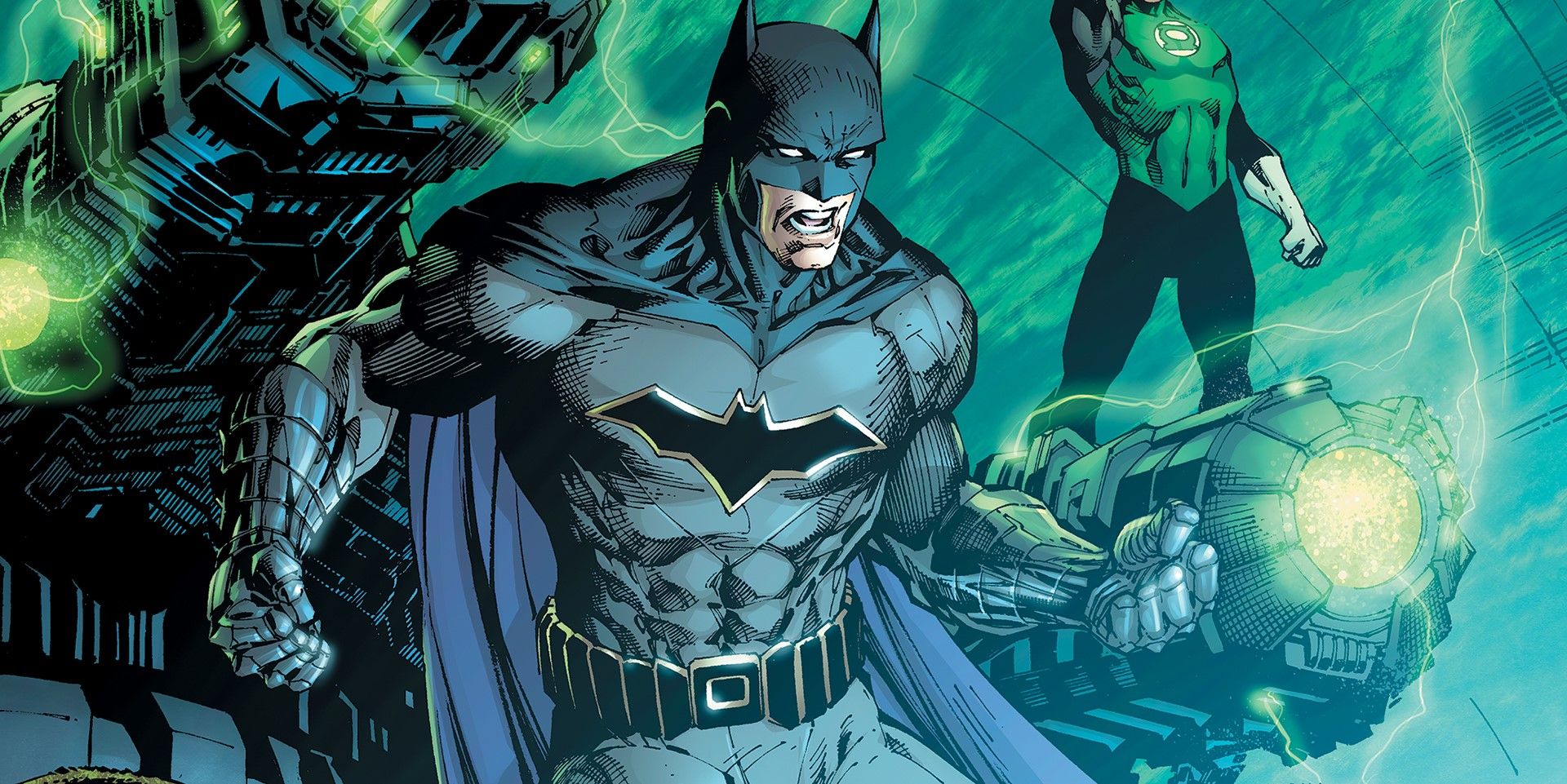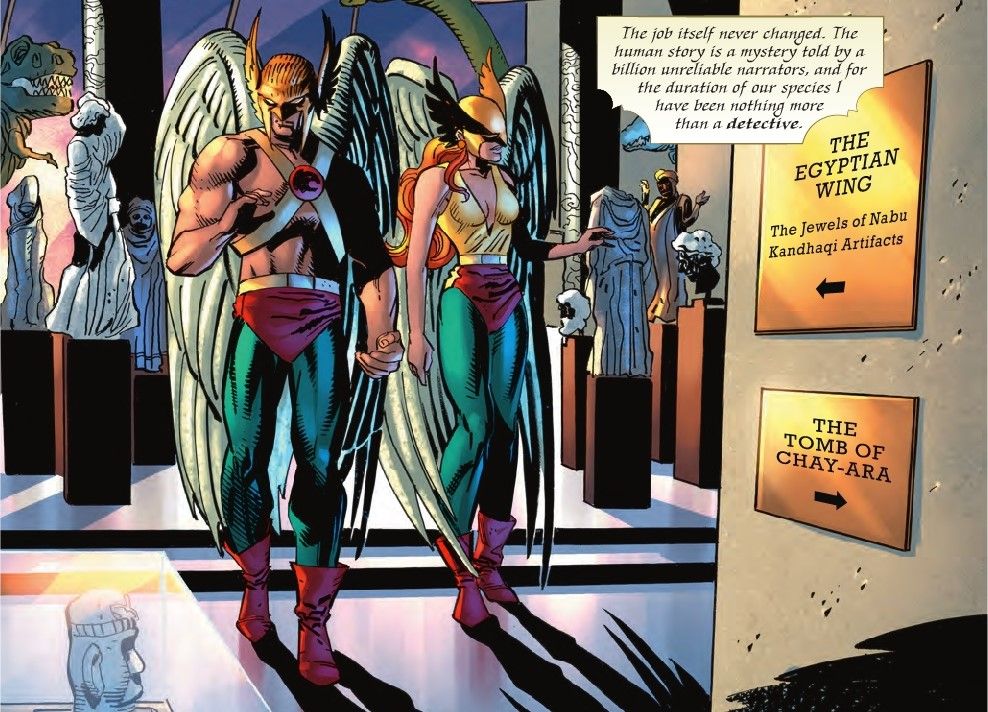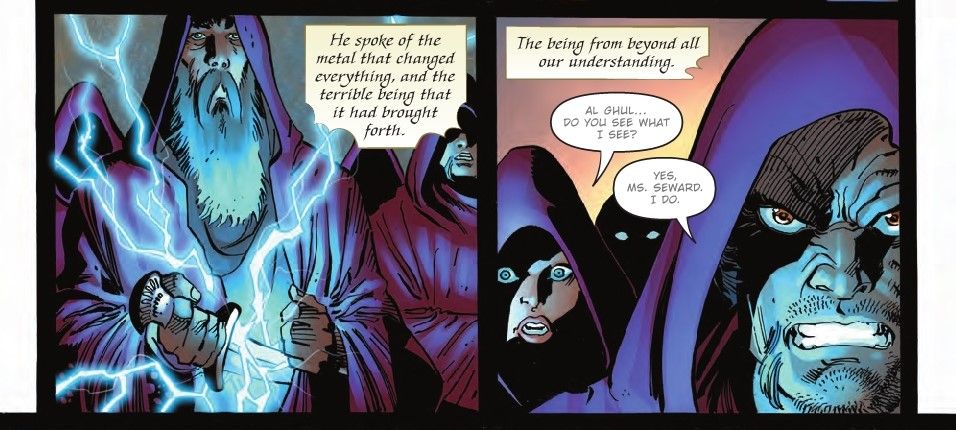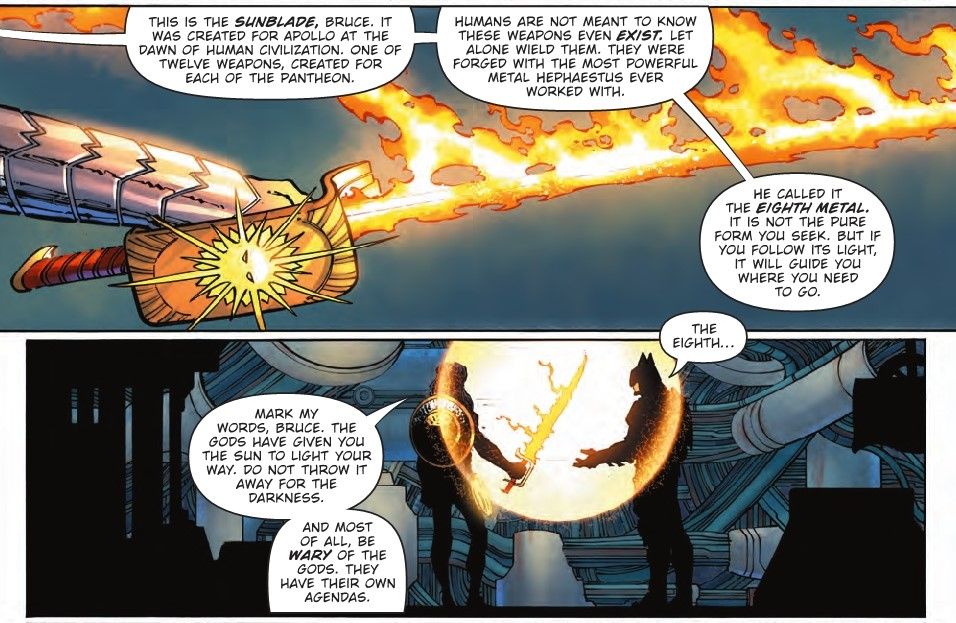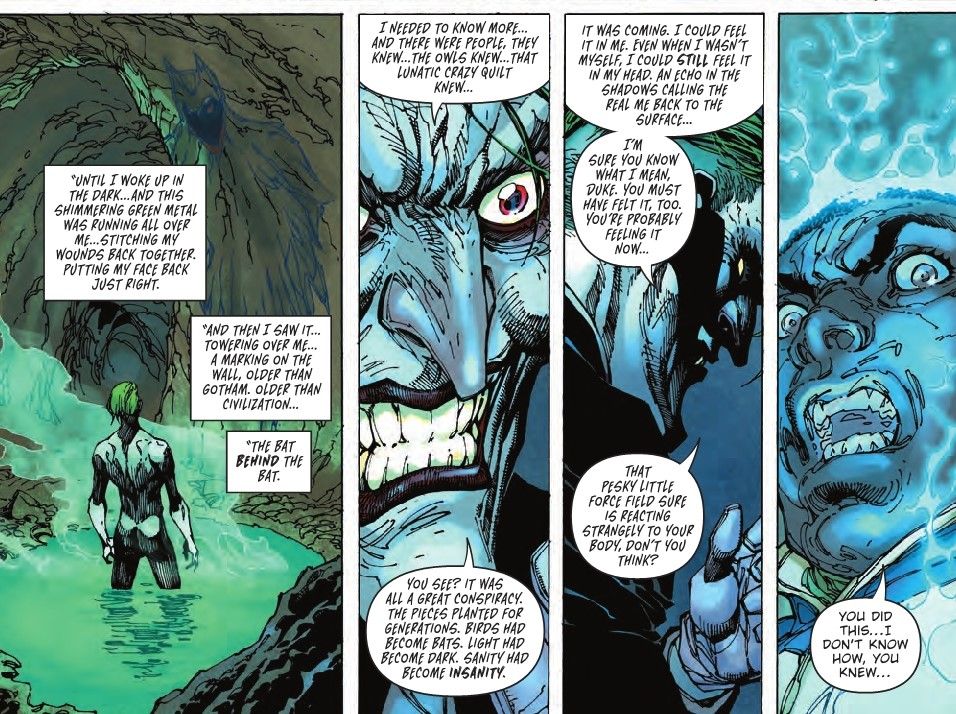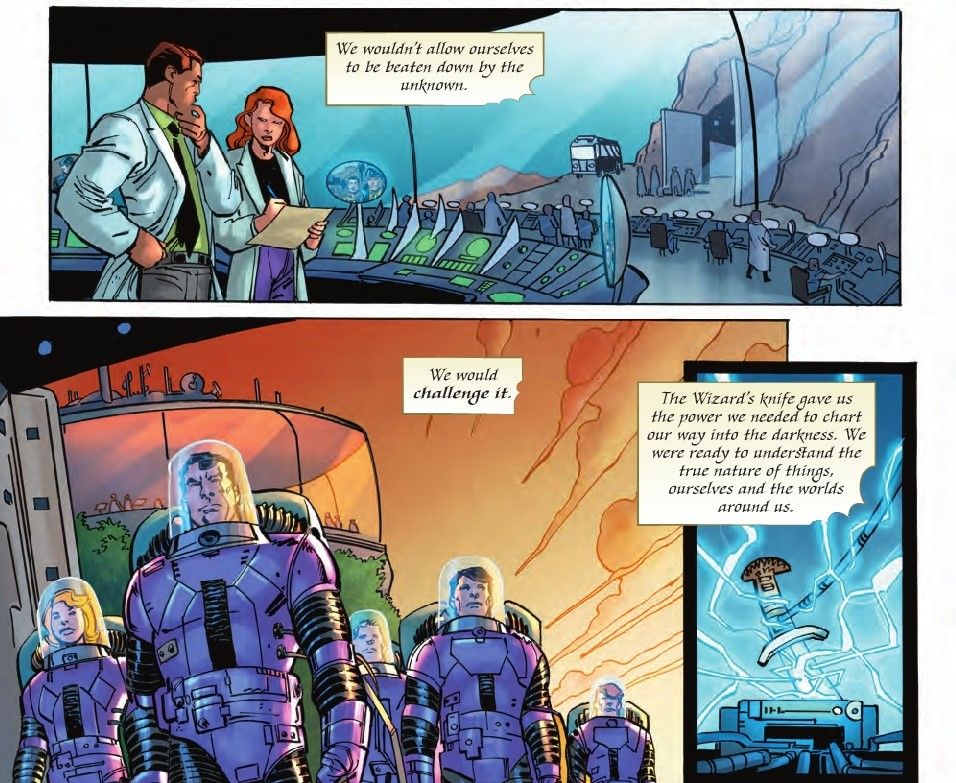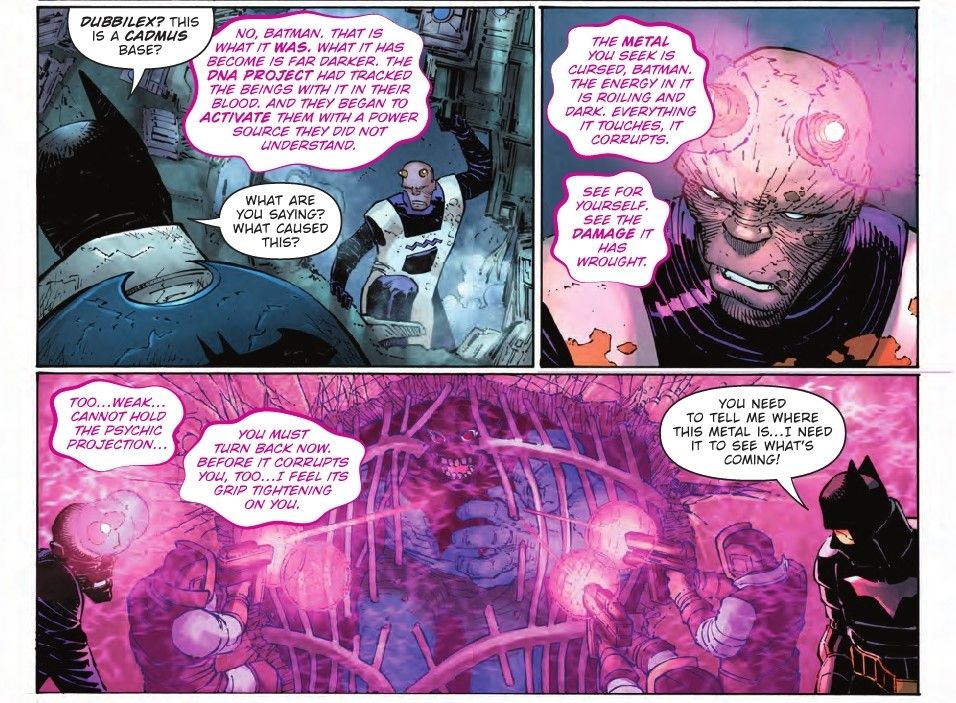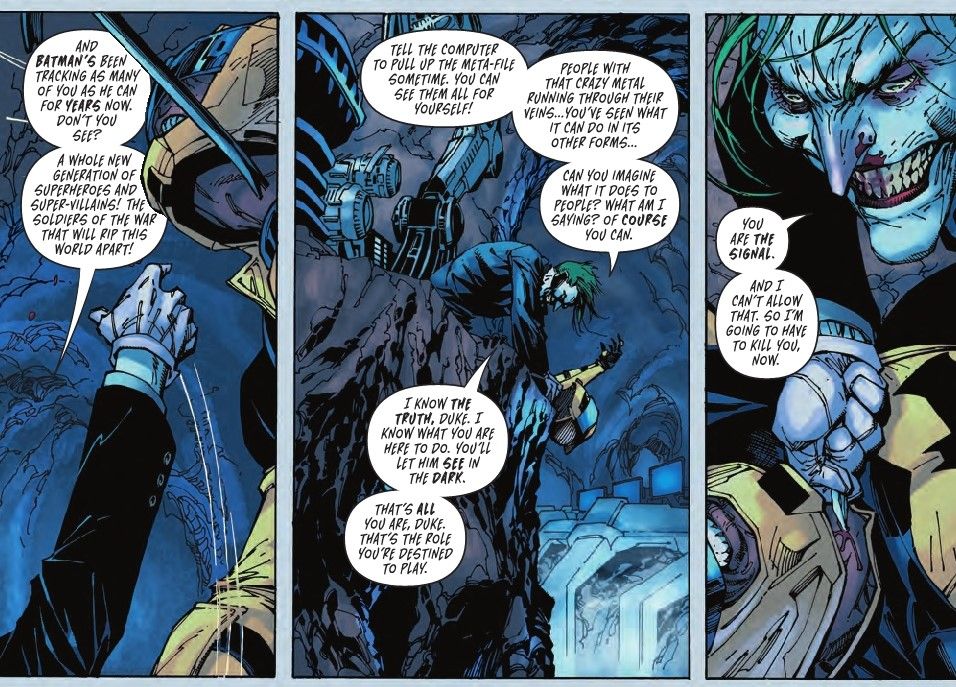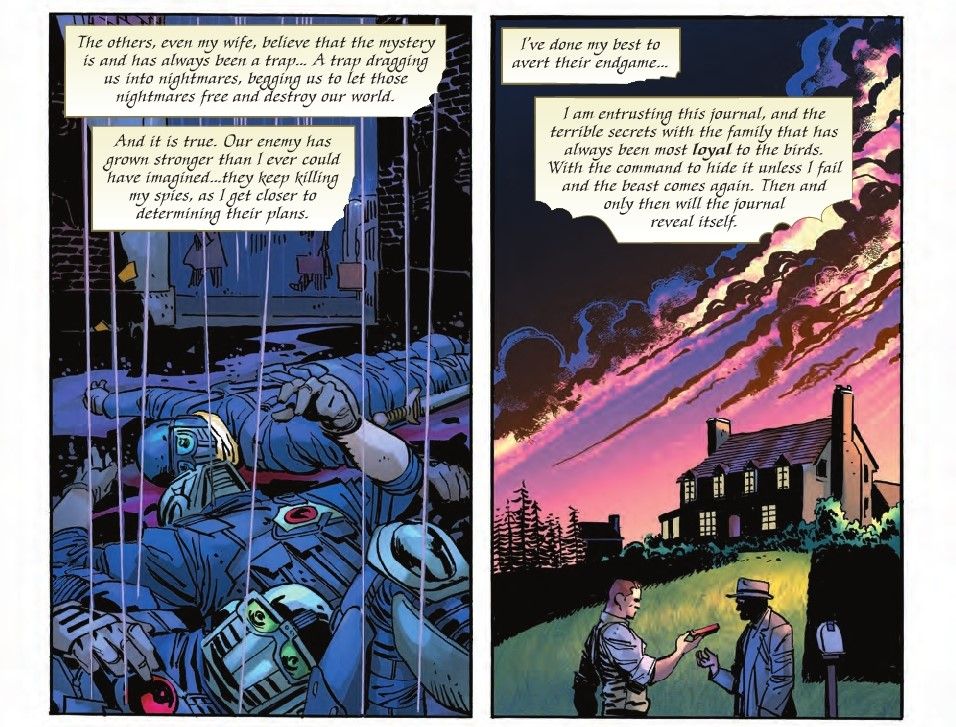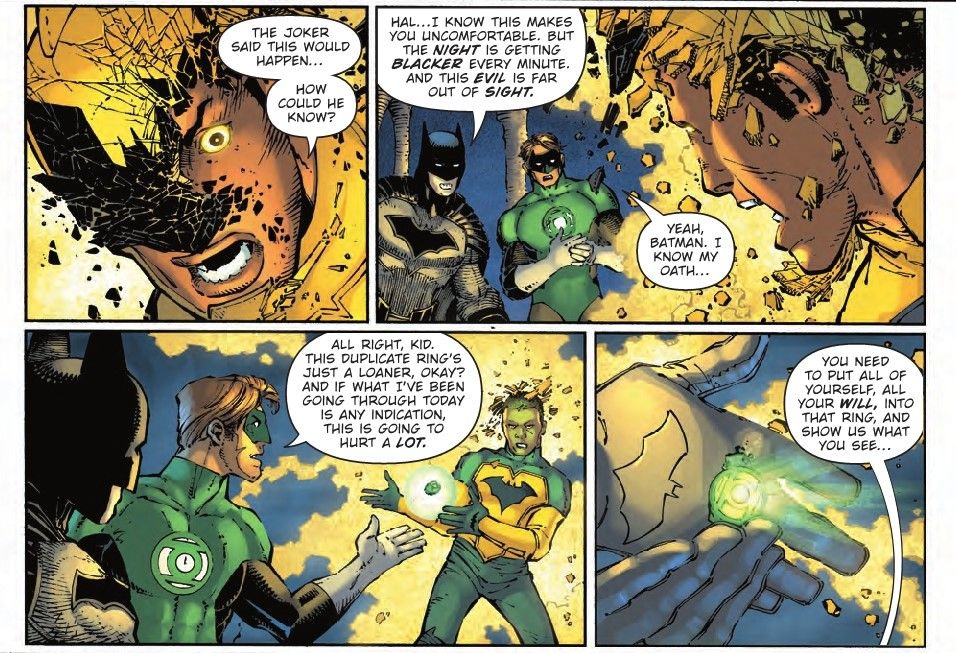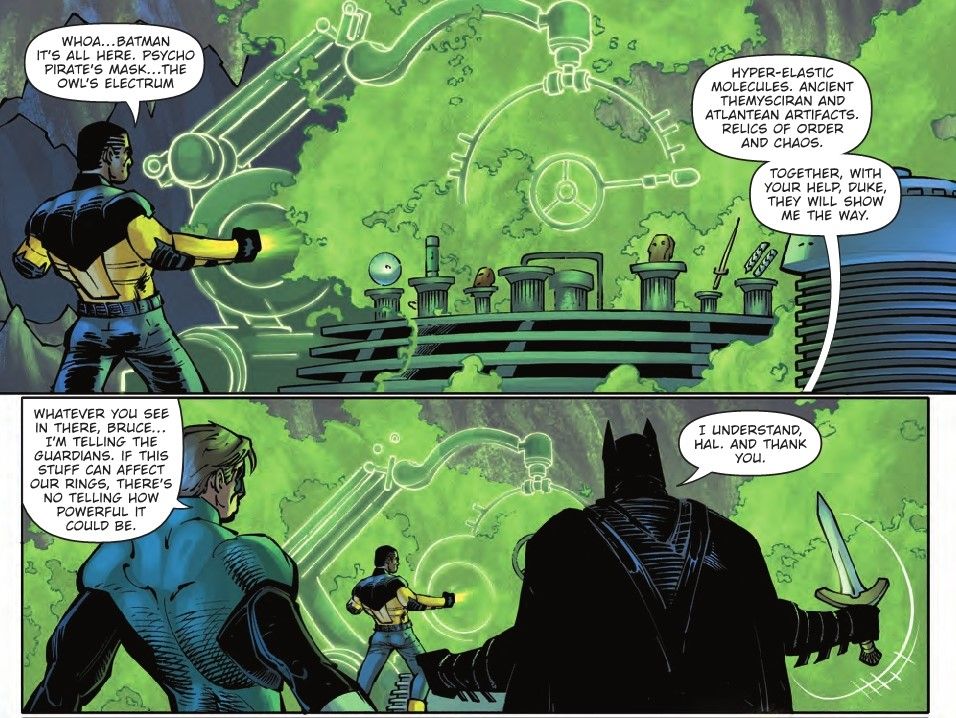Dark Days: The Casting continues the buildup to Dark Nights: Metal, the DC Comics event characterized as Scott Snyder and Greg Capullo's “rock ‘n’ roll epic.” Essentially Part 2 of the story begun in June's Dark Days: The Forge, The Casting advances Forge's three main plots: Hawkman's story, Batman's quest, and Green Lantern and Duke Snyder's encounter with the Joker.
Written by Snyder and James Tynion IV, and penciled by Andy Kubert, Jim Lee and John Romita Jr., Dark Days: The Casting is packed with Easter eggs, and potential clues to the larger story, and mystery, of Metal -- and, as with The Forge, we've set out to break them down.
We'll try not to retread the ground covered in annotations for The Forge or for the Metal preview. However, as we discuss The Casting in excruciating detail, there are major spoilers from here on out.
Concerning the Plot
Perhaps the most intriguing of Casting's three storylines belongs to Hawkman. That sentence may surprise a lot of superhero fans, because for the past several years Hawkman has been saddled (fairly or not) with both a complicated backstory and a somewhat-bland personality. Casting tackles the former head-on by reframing it. Instead of the Hawks' stories beginning with their deaths in Egypt, Casting contends their ancient enemy Hath-Set had actually robbed them of their past. In response, the Hawks gathered other immortals and created unexpected alliances, thereby weaving themselves tighter into the fabric of DC Universe history. Hawkman's portion of The Casting ends, and Carter Hall's narration comes to a close, as he steps into an extradimensional portal.
RELATED: DC's Dark Days: The Forge, Annotated -- Part 1
Meanwhile, Batman receives another ancient blade from Wonder Woman and passes it along to Talia; and Green Lantern and Duke defeat the Joker as more clues emerge about Duke's mysterious past. These subplots converge in the Batcave when Batman reactivates his own "immortality machine," last seen in the "Superheavy" arc.
Now, grab your copy of The Casting and let's get started!
Hawks Through History (Pages 1-3)
At the risk of making Hawkman any more confusing, setting St. Roch as his home "in the first decades of the Twentieth Century" is probably a continuity tweak. Yes, the Golden Age Hawkman was an archaeologist, but St. Roch (an analogue/clone of New Orleans) first appeared in May 2002's Hawkman #1, set after Carter Hall's return in JSA. The Hawks' costumes are also a bit anachronistic, as they're more like the Silver Age versions (especially Carter's helmet/mask, which shows more of his face than the Golden Age one). Regardless of era, the Hawks tended to wear boots with pointed tops and yellow stripes; but we'll chalk that up to artistic license and/or laundry day.
Shiera Sanders (Hall) appeared in the first Hawkman story, in January 1940's Flash Comics #1. However, she didn't put on a Hawkgirl costume until June-July 1941's All Star Comics #5, and didn't "officially" become Hawkgirl until December 1941's Flash Comics #24.
References to Nabu and Kandhaq are, of course, Easter eggs for Doctor Fate and Black Adam. The "nothing more than a detective" remark is probably just an aside, but Hawkman did have an occasional backup feature in Detective Comics throughout the 1970s.
Page 2 assembles 13 Immortals. The red-hooded robes are an ominous detail – what could get these formidable beings to wear matching outfits? – that indicates that whatever they're prepared to discuss is important enough to present a unified front. We'll meet three of them on Page 3, and Hawkman's narration calls out most of the rest. The "Rhyming Demon of Camelot" refers to Jack Kirby's creation Etrigan, who debuted in August 1972's The Demon #1. The "brothers who kept secrets and mysteries" are Abel and Cain. Patterned on the Biblical brothers, Cain was always visiting horrible, gruesome punishments on Abel. Cain was created by Bob Haney, Jack Sparling and Joe Orlando to be the Cryptkeeper-esque "host" of House of Mystery, where he appeared from Issues 175 (July-August 1968) through Issue 321 (October 1983). Likewise, Abel (created by Mark Hanerfeld, Bill Draut and Joe Orlando) debuted in July-September 1969's DC Special #4 and hosted House of Secrets from Issue 81 (August-September 1969) through October-November 1978's Issue 154. Later, both became supporting characters in The Sandman.
RELATED: DC's Dark Days: The Forge, Annotated -- Part 2
The "man as old as America" is Uncle Sam, introduced by Will Eisner in July 1940's National Comics #1. Originally the spirit of a Revolutionary War soldier, his backstory has since expanded to become the near-literal (and practically omnipotent) "Spirit of America." The "grove of ancient humanoid plants" refers to the Parliament of Trees, created by Alan Moore and Stan Woch. First appearing in April 1986's Swamp Thing #47, the Parliament consisted of Plant Elementals that had retired from protecting the Earth's plant life. The reference to "sorcerers" is understandably vague, because DC has a bunch of them. The Golden Age included Sargon the Sorcerer (created by John B. Wentworth and Howard Purcell and appearing first in May 1941's All-American Comics #26), and Zatara the Magician (created by Fred Guardineer and first appearing in June 1938's otherwise-unremarkable Action Comics #1), as well as Ibis the Invincible (created by Bill Parker and Bob Kingett and first appearing in February 1940's Whiz Comics #2), and, of course, Doctor Fate.
We're not sure why Hawkman applies the plural to Shining Knight and Phantom Stranger, as they have tended to be rather singular characters. Created by Creig Flessel, the Golden Age Shining Knight was Sir Justin of Camelot, who debuted in September 1941's Adventure Comics #66. The Phantom Stranger was introduced by John Broome and Carmine Infantino in August-September 1952's Phantom Stranger #1. Speaking of plurals, the "cavemen" no doubt refer to the Immortal Man and his nemesis Vandal Savage.
By the way, we hadn't forgotten about Sir Ystin, the Shining Knight of Grant Morrison and Simone Bianchi's Seven Soldiers miniseries (and later of the New 52's Demon Knights). However, because this scene takes place during the Golden Age or thereabouts, and Sir Ystin time-jumped from antiquity to the 2000s, it's more likely that these Immortals included the classic Sir Justin. We're happy to be proved wrong -- we're big fans -- but it'd require a previously untold chapter of Sir Ystin's backstory.
The wizard Shazam has the "voice ... like the rumble of thunder" and news that "hit us like lightning." Created by Bill Parker and C.C. Beck, he debuted in February 1940's Whiz Comics #2 but has powered the Marvel Family for thousands of years, from Black Adam to Billy Batson and company. However, we think his dagger is new to this story. "Ms. Seward" is Mary Seward, aka "Mary, Queen of Blood" from the I ... Vampire! feature. Created by J.M. DeMatteis and Tom Sutton, Mary first appeared in March 1981's House of Mystery #290. Turned into a vampire in 1591 by her lover Andrew Bennett, eventually she led the vampire clan called the Blood Red Moon, while he spent the subsequent centuries trying to undo his mistake and defeat them. Mary's associate Rā's al-Ghūl needs no introduction, so we'll just note that he was introduced by Denny O'Neil and Neal Adams in June 1971's Batman #232.
The Blade and The Bat (Pages 4-6)
Methana, Greece, is a real place, situated on a volcanic peninsula. This continues Batman's tour of volcanoes from his trip to the Bermuda Triangle in The Forge. Amphitryon comes from Greek mythology, but it doesn't involve a hippogriff. Instead, it's a tragedy about mistaken identity and murder.
Hephaestus was a big part of the New 52 Wonder Woman, especially the initial Brian Azzarello/Cliff Chiang issues. However, the Rebirthed Wonder Woman has taken the gods out of the picture, as Diana explains here. Furthermore, far be it from us to argue with Wonder Woman, but we thought Apollo was known better as an archer than a swordsman; maybe Diana has the sword because Apollo wasn't using it. While we're on the subject, we'll remind you that Wildstorm's Apollo began as a Superman pastiche, and that Superman himself is powered by yellow solar energy. Thus, we expect Superman to encounter the Sunblade at some point during Metal.
The "Eighth metal" goes along with Nth metal originally being called "Ninth metal," as it was in Hawkman's debut (January 1940's Flash Comics #1). In what seems now like a bit of a swerve, Flash #1 states that Hath-Set used a glass dagger to kill Khufu and Chay-Ara.
Signals and Omens (Pages 7-9)
The Joker basically recaps Duke's parents' roles in "Endgame," and goes on to list most of his New 52 appearances. He cut off his face in November 2011's Detective Comics #1, tried to kill Batman's "whole family" in the "Death of the Family" crossover, and was apparently healed by Dionesium after the events of "Endgame" and/or "Superheavy."
We read Duke's shocking (sorry) situation on Pages 8-9 as the force field tapping, or perhaps activating, his latent superpowers.
"The Bat behind the bat" may refer to Barbathos, the bat-demon summoned by 18th-century occultists operating on the future site of Gotham City. As related in the 1990 storyline "Dark Knight/Dark City" (Batman #452-454) and 2010's Return of Bruce Wayne miniseries, Barbathos wasn't just a demon "haunting" the foundations of Gotham, but a "Hyper-Adapter" released by Darkseid to chase Batman across time and destroy all of creation in the process. Naturally, its mission failed, and it was killed in the Stone Age by Vandal Savage. Page 10's revelation that a "tear in the fabric of reality" brought the bat-demon into this world "from the dark" suggests it came from the Dark Multiverse. This isn't necessarily inconsistent with the bat-demon being Barbathos, but the Dark Multiverse is supposed to be something entirely new, not another Darkseid-related plot.
Blackhawks and Challengers (Pages 10-12)
As much as we're tempted to blame every evil Stone Age act on Vandal Savage, betraying the Hawk Tribe to the Bat's forces may have been the work of Hath-Set's ancestor. Vandal was part of the Blood Tribe, and his nemesis Immortal Man came from the Bear Tribe. Also, while "[b]irds and bats, forever at war" clearly fits in with the overall Court of Owls storyline, it's not as compatible with Hawkman and Batman's friendship (not to mention Batman and Robin's).
According to Page 11, Hawkman and Hawkgirl spent much of the 20th century supporting the Blackhawks and the Challengers of the Unknown? The Blackhawks have a pretty mundane wartime origin and the Challengers didn't get together until the mid-1950s (1957 in the real world). The Hawks' classic history has them retiring with the rest of the Justice Society in 1951, and returning to active duty several years later after the events of "Flash of Two Worlds." If these Hawks have the same overall backstory, their work with the Blackhawks and Challengers spans both their wartime adventuring and their post-retirement activity.
The destruction of Challengers Mountain may explain why the team hasn't been seen in a while; but we know from the Metal preview that the mountain will be back.
Alien and Assassin (Pages 13-15)
The Sonoran Desert stretches from the southwestern United States into Mexico. Movie buffs may remember its Mexican portion from the opening scene of Close Encounters of the Third Kind, where it hosted a squadron of time-lost World War II fighter planes. In that respect, we're sorry to report those planes were Grumman TBM Avengers from the vanished Flight 19, not Grumman XF5F Skyrockets like the Blackhawks flew.
Batman's "shadow drive" recalls his Black Casebook, Grant Morrison's term for the weird sci-fi/fantasy-inflected adventures Batman and Robin went on during the 1950s and early 1960s.
RELATED: What We Mined From DC's Dark Nights: Metal Preview
Dubbilex, Cadmus and the DNA Project are from Jack Kirby's norm-shattering run on Jimmy Olsen in the early 1970s. Cadmus and the DNA Project debuted in October 1970's Issue 133, while Dubbilex first appeared in April 1971's Issue 136. Dubbilex is a humanoid modified into a "DNAlien," with an otherworldly appearance and telekinetic and telepathic abilities. The New 52 reworked Cadmus for its OMAC revamp, while the Supergirl TV series has used Cadmus as a xenophobic terrorist group. Neither of those versions seems to be part of this traditional take.
Debuting in May 1971's Detective Comics #411, Talia al-Ghul was created by Denny O'Neil and Bob Brown. She is Damian Wayne's mother and the former head of the criminal organization known as Leviathan (from the Grant Morrison-written Batman Incorporated). The reference to the "ruins of a private military base in the Rocky Mountains" sounds like the remains of Challengers Mountain. The Silencer refers to one of Metal's spinoffs, debuting in the fall. "The power of Shazam!" (exclamation point included) was the title of Jerry Ordway's Captain Marvel relaunch, which started with a 1994 graphic novel and continued as a 1995-99 ongoing series.
Batman Forever (Pages 16-19)
The Bat-reincarnator (for lack of a better term) from the end of "Superheavy" makes a comeback in this sequence, and the version of the Batwing is the one from Batman: The Animated Series. Other than that the big revelations appear to be the Joker's connection of "meta" to "metal" -- we suppose Batman has been tracking individuals with Dionesium, Nth Metal or other exotic materials in their bodies -- and the Joker's strong suggestion that Duke's eventual code name will be "Signal."
Bye Bye Birdie? (Pages 20-22)
Speaking of super-residential tropes, it looks like Hawkman has gotten his own mansion-and-underground-lair setup. We admit we're not completely up to speed on the history of Hawkman's houses, and it's certainly possible he lived in a mansion as far back as January 1940's Flash Comics #1, but he always seemed more like a high-rise kind of guy.
In any event, Page 20 appears to depict the remnants of the Thanagarian ship that crashed in ancient Egypt, practically picked clean of its Nth metal and turned into a portal. Hawkman's musings about his "final entry" suggest that all of his story, including the present-day elements, has largely been flashback. That may make his overall timeline a little fuzzier, and therefore easier to link with the Death of Hawkman miniseries. Still, we're thinking that the Carter of Dark Days will turn out to be different from the Katar of DOH.
RELATED: Scott Snyder Opens Up About Dark Nights: Metal’s Biggest Mysteries
Page 21 offers some more connective tissue, calling the new-style Blackhawks (who we'll see again in Metal) "my spies" and alluding to "the family that has always been most loyal to the birds." That family is couched in such cryptic terms that we're tempted to say it's probably an existing DC bunch. Maybe it's Shiera Sanders and her relatives, including future Hawkgirl Kendra Saunders, or maybe it's a more obscure Hawk-ally; but our money's on a different Hall family entirely. Hank and Don Hall, akaHawk and Dove, were created by Steve Ditko and Steve Skeates and first appeared in June 1968's Showcase #75. Although they represented "war and peace" at the tail end of the tumultuous 1960s, in the 1980s (with new Dove Dawn Granger) they became agents of the Lords of Chaos and Order. If Metal is going to be a timey-wimey mashup of science and magic, Hawk and Dove would be good fits. Doctor Fate is a Lord of Order, and in previous continuity Hawk became the time-traveling despot called Extant. In fact, Carter Hall's son Hector served as Doctor Fate for a while.
The C-Word, Duke's Destiny and the Impossible Batmen (Pages 23-30)
As The Casting's remaining subplots collide, and the issue races to its conclusion, there's not much more to discuss. On Page 22 the Joker drops the C-word ("crisis"); while on Page 24, Green Lantern reminds Batman of the "Three Jokers" subplot from Justice League #50. When Batman mentions "impossible versions of [himself] dying" on Page 25, he's alluding to the myriad of alternate (or potential) future Batmen from the end of "Superheavy."
Page 23's line that "the puzzle" is "always ... in the form of a bat" got us thinking about one of the 52-part Multiverse's underpinnings. At the end of 52, Rip Hunter and Booster Gold watched Mister Mind (another Captain Marvel villain) tear through the Multiverse, altering each parallel universe's history as he went. Despite the killer insect's rampage, most (if not all) of the 52 universes which remained had some version of Superman, even if it was Earth-4's Captain Atom or Earth-10's Overman. Many of these Supermen teamed up at the end of Final Crisis. Of course, most (if not all) of these 52 universes also had a Batman – but if Superman represented the ultimate superhuman figure, what if Batman represented the darker impulses which helped hold the world together? It may be a little melodramatic, but we'll see how it plays out.
Although it's probably more artistic license – not to mention the worst kind of fannish stereotype – we'd also like to point out on Page 25, Green Lantern's ring is on the wrong finger. He's got it on his right pointer, as opposed to his middle finger (where it usually goes, and where Duke's goes just a page later) or his ring finger. At least Hal knows his oath. Say it with us, as you touch your ring to the nearest lamp: In brightest day, in blackest night, no evil shall escape my sight! Let those who worship evil's might beware my power -- Green Lantern's light!
Speaking of which, we like to imagine that Batman's quasi-recitation comes with some very pointed nudge-nudge inflections, just short of him poking Hal in the ribs. ("Eh? Eh?!?")
Not every Green Lantern ring can create duplicates. Kyle Rayner's could, back in the days when he was the last GL (or the "Torchbearer," as he was later known), but only after an encounter with Parallax in July 1998's Green Lantern #100. The current duplicative quality of Hal's ring comes from complicated Reasons (involving an issue or so when Hal was pure emerald energy) in the early issues of Hal Jordan and the Green Lantern Corps. However, this looks like Hal making a no-frills version of a power ring, kind of like he did for Wally "Kid Flash" West in Mark Waid and Barry Kitson's retro-styled Flash and Green Lantern: The Brave and the Bold miniseries.
Batman having Psycho-Pirate's mask is a bonus from breaking the Pirate out of Bane's Santa Priscan prison (the "I Am Suicide" arc in Batman issues 9-13, December 2016-February 2017). The Psycho-Pirate is also one of the few beings in DC's creation who remembers the original, pre-Crisis On Infinite Earths Multiverse, so his mask probably has some cosmic harmonic mojo.
Not only does Duke get to wield a Green Lantern ring while wearing a Bat-inspired costume, he seems to have an affinity with Shazam's dagger. This makes us think – if the evil Bat-mashups are Batman combined with another hero, who's to say that good-guy Duke won't have his "Bat-ness" removed at some point? Maybe his reaction to the dagger indicates a future with the Marvel Family?
As mentioned above, "[r]elics of order and chaos" are indicative of the Lords thereof. By planting that (short) sword into a (stone) column, Casting also goes for a much more recognizable set of symbols.
Page 28's "[a]ll I saw was darkness" doesn't refer exactly to the Dark Multiverse, since Page 29 reveals it to be the Bat-cultists "preparing" Batman. As discussed previously, the "true father of Batman" might be Barbathos, or something much greater. Finally, Page 30 hopes you like tie-ins!
What did you get out of Dark Days: The Casting? Let us know in the comments.

